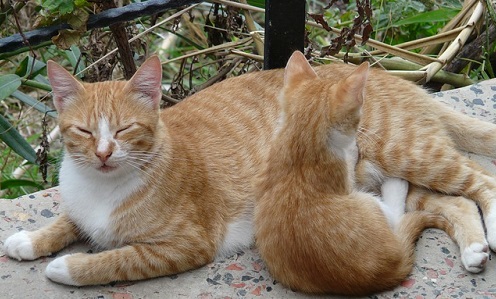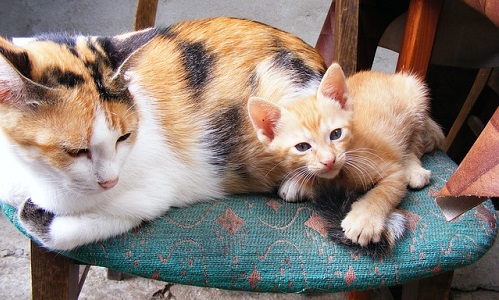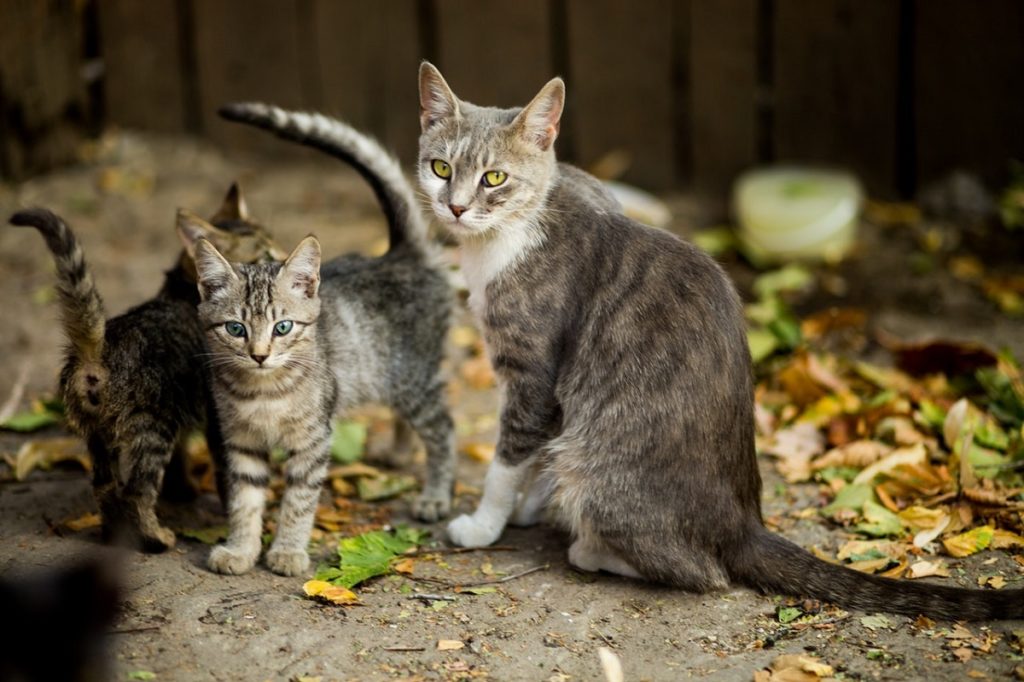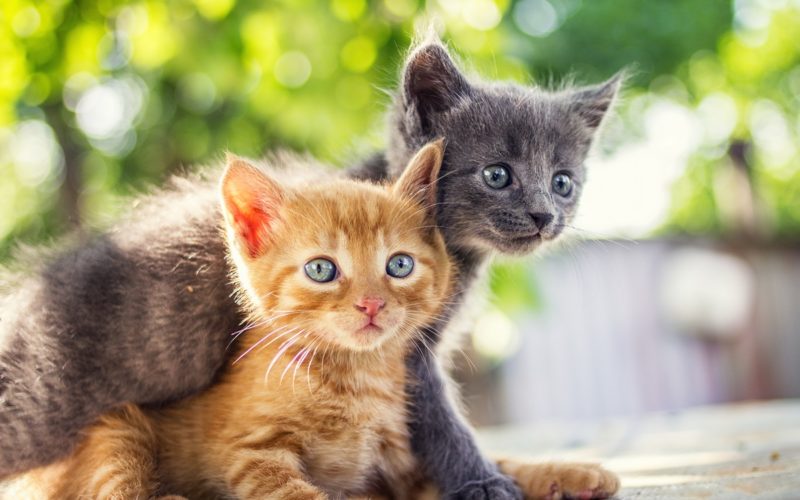Cats are a long-lived pet, with some felines enriching the lives of their human companions for fifteen years or more. That said, cat pregnancy is a fascinating and relatively short event that ends in the happy arrival of multiple tiny kittens – but exactly how long is a cat pregnant for? As a cat owner, you’re likely anxious for the arrival of your new family members, and cats are notoriously skilled at hiding everything from pregnancy itself to concealing pain during periods of injury or illness. Here are a few ways to determine what stage of pregnancy your kitty is in – and how much longer you’ll have to wait for “the big day.”
- Her Size: Cat pregnancy and human pregnancy share a lot of common symptoms, including the less pleasant ones, like morning sickness. The visual progression of cat pregnancy is also a familiar one. Your cat will get bigger and rounder as her pregnancy progresses, but the best “tell” for how close she is to giving birth is the most obvious one: she will be very large around her sides and belly, and you may be able to feel or see fetal kitten movement in her stomach if she allows you to hold or touch her. This usually means she’s less than two weeks from giving birth, and if her nipples are “leaking” milk, that timespan shortens to mere days – get that birthing box ready!
- Her Appearance: A pregnant cat’s nipples tell a great deal about her pregnancy, darkening and swelling noticeably only three to four weeks into a cat pregnancy that lasts approximately nine weeks. This is one of the most reliable early-on signs of pregnancy in cats, and it is a particularly visible phenomena in first-time cat mothers.
- Her Time of Conception: Assuming that your kitty isn’t constantly exposed to an unneutered tom (male) cat, knowing when she might have been “visiting” with one can also help you narrow down her pregnancy stage. If your unspayed female cat temporarily escapes or an unneutered male cat makes it into your home, make a note of the day so you remember to examine her for cat pregnancy signs in a week or two.
- Her Appetite: Carrying a typical litter of 3 to 5 kittens takes a lot of room in the abdominal cavity, which means there isn’t as much room for food. If your cat has a loss of appetite, that means the babies are getting larger – the less she eats, the larger they’re likely to be. This is why it’s very important to give her consistent access to high-nutrition food, ideally a blend made specifically for pregnant and nursing cats, and feline nutritional supplements to get the most mileage out of her volume-limited diet. Of course, if she stops eating altogether, behaves like she is disoriented, or looks sickly, be sure to take her to your veterinarian’s office immediately.
- Her Behavior: Your cat is acutely aware of the changes her body is going through, and maternal instinct is a powerful force. Just as human mothers are driven to clean, organize, and settle their home just prior to labor – an urge popularly called “nesting” – cat mothers-to-be are driven to do the same. If your cat feels she is about to go into labor in the next day or two, you may find her inspecting safe, enclosed areas for the birthing process, such as a closet or under a bed. The best way to avoid a mess and an inconvenient birthing place is to offer her several choices of boxes or spaces lined with soft blankets; also ensure her birthing area is protected from other pets, foot traffic and preferably in a quiet spot.
Did You Know…
 Be aware that your kitty will likely have an uptick in her demand for food just before the kittens start really gaining weight and size while in utero. Around week six of her pregnancy, you’ll notice her “cleaning her bowl” a lot more reliably, and potentially even begging for more wet food or kibble by showing affection, rubbing against your ankles, and so on. Allow your cat to have as much food as she needs: instinct will let her know when she’s had enough!
Be aware that your kitty will likely have an uptick in her demand for food just before the kittens start really gaining weight and size while in utero. Around week six of her pregnancy, you’ll notice her “cleaning her bowl” a lot more reliably, and potentially even begging for more wet food or kibble by showing affection, rubbing against your ankles, and so on. Allow your cat to have as much food as she needs: instinct will let her know when she’s had enough!
What Happens in Cat Pregnancy?
Cats have a fascinating feline pregnancy process – not only do they need to “visit” with a male tom cat to induce ovulation before actually conceiving, a female cat can potentially have two cats father a single litter of kittens! If you’ve ever seen a litter of kittens where half the siblings didn’t seem to match the other half at all in appearance, this might be the reason why. Male cat sperm can remain viable in the female for awhile after mating occurs, so if a female cat visits with more than one tom cat in a short period of time, she may bear kittens from each. This is called heteropaternal superfecundation, which is essentially a fancy way of saying “fertile enough to have babies with more than one kitten parent.”
Once fertilization occurs, the kittens cozy up in individual channels within the uterus, protected by double layers of membrane so they can each grow strong and healthy within the mother. During birth, these kittens will emerge one at a time, protected during their journey down the birth canal by these slippery membranes, which help ensure they don’t get stuck or lodged. The mother cat will nip and lick the membranes away from their tiny nose and mouth once they emerge to encourage them to start breathing.
Cat pregnancy will last between nine and ten weeks from fertilization, or between 58 and 72 days, depending on your cat’s breed, age, and factors such as health and availability of nutrients. Asian breeds such as the Siamese may carry their young for a few days longer than their American short hair cousins, but cats will generally give birth within ten weeks of conception. If you know your cat is pregnant and the kittens have not made their appearance by week 10, it’s a good idea to contact your vet and make an appointment for an assessment, as the little ones might need medical assistance to make their debut.
How Long Will My Cat Be in Labor?
Like your cat’s overall pregnancy, a lot depends on her. Cats that feel well-protected and safe will naturally feel more at ease when giving birth, but if your home is noisy, crowded, or otherwise anxiety-inducing to your kitty when she’s at her most vulnerable, labor will take longer. You can expect that she will need between 5 and 30 minutes for each kitten, which means that the physical portion of labor can happen over the course of several hours. During this time, it’s helpful to remain nearby if your cat finds comfort in your presence, or to leave the room if your presence seems to be annoying or agitating her. Cats are seldom shy about showing their feelings, and a queen in labor tends to send very clear signals about what she does and does not want while she’s bringing her kittens into the world. Make sure she has food, water, and a litter box readily available, and allow nature to take its course!
There is a chance, though small, that labor could “pause” in the middle – an event called interrupted feline labor. If this occurs, there’s nothing to worry about – your cat may eat and drink normally, allow the kittens that have emerged to nurse, and otherwise relax, even if she still has obvious kittens inside of her, waiting to be born. This can happen for a variety of reasons, including your leaving the home or going to work, and your cat can resume giving birth as much as 24 to 36 hours later, with the remaining kittens still in perfect health.
What Can I Expect After My Cat Gives Birth?
After all of her kittens have made their appearance, your feline companion will be understandably tired! You can help her relax by ensuring that there are no distractions – dogs, cats, children, visitors, and so on – around her birthing area. Her kittens still have closed eyes and are extremely helpless at this point, so she is hyper-alert even in her exhaustion. Removing dangers before they can put her on edge allows her to focus on grooming and feeding her little ones instead of keeping watch.
 While you should handle the kittens as little as possible, if you do need to move or reposition them, make sure to wash and dry your hands before and after handling them. Ideally, the mother cat and kittens should be allowed to stay where they are for as long as possible, as this will minimize stress and risk on the whole furry family. If you notice a kitten looks like a “runt” and isn’t reliably reaching one of your cat’s teats for milk, you can gently place them beside an unoccupied nipple to encourage them to latch and feed. If the kitten consistently fails to latch and feed in the first day or two, discuss the possibility of supplementing with cat milk formula and a bottle with your vet.
While you should handle the kittens as little as possible, if you do need to move or reposition them, make sure to wash and dry your hands before and after handling them. Ideally, the mother cat and kittens should be allowed to stay where they are for as long as possible, as this will minimize stress and risk on the whole furry family. If you notice a kitten looks like a “runt” and isn’t reliably reaching one of your cat’s teats for milk, you can gently place them beside an unoccupied nipple to encourage them to latch and feed. If the kitten consistently fails to latch and feed in the first day or two, discuss the possibility of supplementing with cat milk formula and a bottle with your vet.
Kittens don’t have the ability to reliably regulate their body temperature at birth, so lining the birth area with a warm material, such as a fleece material blanket, can help your cat keep her babies warm. While you should also continue to keep food and water close by for your cat’s convenience, make sure the newborn kittens cannot reach the water to prevent potential accidents.
Tips for Caring for Newborn Kittens
In general, unless a kitten isn’t feeding off its mother or appears unusually sickly, it’s best to leave care of the kittens in mama cat’s capable paws until the kittens’ eyes open. Once they start growing some soft fur and wandering around on their own, you can potentially load the family into a cat carrier for their first vet checkup. Kittens can’t receive many of their vaccinations or products like topical flea treatments until they’re older, but a vet can record things like weight, parasite checks, and gender of the newborn kittens.
Good quality kitten food is important when the time comes to wean your kittens at about 4 to 5 weeks of age; a pate-style wet food can be mixed with kitten formula to help ease the transition. Try adding a pinch of catnip to encourage them to use the box and avoid accidents as they start “potty training” with their mother. Plenty of appropriate scratching surfaces and fun toys to play with will help spare your furniture from the ravages of tiny, adorable claws.
Giving Your New Kittens a Great Start
In the coming weeks and months, unless you are planning on breeding cats for show or pedigree purposes, spaying and neutering both your pets including the mother cat and her kittens should move to the top of your to-do list.
Not only will cats produce more kittens indiscriminately with their own family members, females and males are both capable of mating from the tender age of 4 to 6 months. Considering that unspayed females are capable of having as many as five litters of kittens a year, it’s little wonder so many stray cats roam the streets in cities across the country. Diligently spaying and neutering your new kittens will help them become part of the solution, rather than part of the problem. In addition, it prevents health issues in both male and female cats, encourages a more loving temperament, and helps them stay calm and happy.
Now that you’ve helped your new kittens enter the world in a safe, healthy way and reduced stress on your beloved feline companion, enjoy their antics and the relief that the kitty “pregnancy watch” is over at last.
Sources Cited:
Kelley, Jane A. “How Long Are Cats Pregnant For? The 5 Stages of Cat Pregnancy.” Catster.com, May 7, 2018, https://www.catster.com/lifestyle/cat-health-5-stages-cat-pregnancy. Accessed Sept. 27, 2018.
“Cat Pregnancy – A Week By Week Pregnancy Calendar.” Pets4homes.co.uk, (no publish date), https://www.pets4homes.co.uk/pet-advice/cat-pregnancy-a-week-by-week-pregnancy-calendar.html. Accessed Sept. 27, 2018.
“How Long Are Cats Pregnant And How Do You Tell When They Are? A Guide To Pregnancy In Cats.” Catalogical.com, (no publish date), https://www.catological.com/pregnancy-in-cats/. Accessed Sept. 27, 2018.




